Evolution and Built-Up Age Dependency of Urban Thermal Environment
Abstract
:1. Introduction
2. Materials and Methods
2.1. Study Area
2.2. Data
2.3. Land Surface Temperature (LST), Urban Expansion Rate, and Urban Development Intensity
2.4. Built-Up Age and Its Relationship with LST
3. Results
3.1. Urban Expansion and Built-Up Age
3.2. LST Changes along the Chronosequence of Built-Up Age Cohorts
3.3. LST Change with Built-Up Age
3.4. Relationships between LST Change and Driving Factors
3.5. Urban Development Intensity (UDI) and the Sensitivity of LST to UDI
4. Discussion
4.1. Temporal Stability of the Spatial Pattern of LST
4.2. Space-for-Time Substitution Inadequate for Urbanization Study
4.3. Temporal Change of Sensitivity of LST to UDI
4.4. Limitations and Future Research
5. Conclusions
Author Contributions
Funding
Data Availability Statement
Conflicts of Interest
Appendix A

| Age | 2000 | 2001 | 2002 | 2003 | 2004 | 2005 | 2006 | 2007 | 2008 | 2009 | 2010 | 2011 | 2012 | 2013 | 2014 | 2015 | 2016 | 2017 | 2018 | 2019 | Mode | SE | 95% CI |
|---|---|---|---|---|---|---|---|---|---|---|---|---|---|---|---|---|---|---|---|---|---|---|---|
| 22 | 1 | 1 | 1 | 1 | 1 | 1 | 1 | 1 | 1 | 1 | 1 | 1 | 1 | 1 | 1 | 1 | 1 | 1 | 1 | 1 | 1 | 0.00 | 0 |
| 34 | 3 | 2 | 3 | 2 | 2 | 3 | 3 | 2 | 2 | 2 | 2 | 2 | 2 | 2 | 2 | 2 | 2 | 2 | 2 | 2 | 2 | 0.09 | 0 |
| 21 | 2 | 4 | 2 | 3 | 3 | 2 | 4 | 3 | 3 | 3 | 3 | 3 | 3 | 3 | 3 | 3 | 5 | 3 | 3 | 3 | 3 | 0.15 | 0 |
| 25 | 4 | 5 | 15 | 5 | 4 | 5 | 2 | 4 | 4 | 4 | 4 | 4 | 4 | 4 | 4 | 4 | 3 | 4 | 4 | 5 | 4 | 0.57 | 1 |
| 26 | 5 | 6 | 10 | 8 | 6 | 6 | 6 | 9 | 7 | 6 | 8 | 7 | 5 | 5 | 5 | 5 | 4 | 5 | 6 | 4 | 5 | 0.36 | 1 |
| 24 | 9 | 8 | 4 | 4 | 5 | 4 | 5 | 5 | 5 | 5 | 6 | 11 | 6 | 6 | 6 | 7 | 6 | 6 | 5 | 6 | 6 | 0.39 | 1 |
| 20 | 8 | 3 | 5 | 6 | 7 | 8 | 7 | 8 | 9 | 10 | 7 | 5 | 7 | 8 | 9 | 8 | 11 | 7 | 11 | 7 | 7 | 0.44 | 1 |
| 23 | 11 | 7 | 9 | 7 | 9 | 7 | 8 | 6 | 8 | 8 | 9 | 8 | 8 | 7 | 8 | 10 | 9 | 10 | 10 | 13 | 8 | 0.37 | 1 |
| 19 | 7 | 11 | 12 | 11 | 8 | 12 | 9 | 12 | 10 | 12 | 11 | 9 | 9 | 10 | 10 | 6 | 7 | 9 | 7 | 9 | 9 | 0.42 | 1 |
| 27 | 10 | 10 | 6 | 9 | 10 | 11 | 11 | 10 | 11 | 9 | 10 | 6 | 11 | 11 | 7 | 11 | 10 | 8 | 9 | 10 | 10 | 0.36 | 1 |
| 33 | 6 | 9 | 7 | 12 | 13 | 10 | 10 | 7 | 6 | 7 | 5 | 10 | 10 | 9 | 11 | 12 | 8 | 11 | 8 | 8 | 10 | 0.50 | 1 |
| 30 | 12 | 16 | 11 | 10 | 14 | 9 | 16 | 15 | 15 | 14 | 12 | 14 | 15 | 12 | 13 | 9 | 12 | 13 | 13 | 14 | 12 | 0.47 | 1 |
| 31 | 13 | 15 | 13 | 14 | 12 | 13 | 12 | 11 | 14 | 13 | 15 | 15 | 12 | 14 | 12 | 13 | 13 | 12 | 12 | 15 | 13 | 0.27 | 1 |
| 32 | 14 | 14 | 8 | 13 | 11 | 16 | 15 | 14 | 16 | 11 | 13 | 16 | 13 | 13 | 14 | 14 | 15 | 14 | 14 | 11 | 14 | 0.44 | 1 |
| 28 | 15 | 13 | 14 | 15 | 16 | 14 | 13 | 13 | 13 | 15 | 16 | 12 | 16 | 16 | 16 | 16 | 14 | 16 | 16 | 12 | 16 | 0.33 | 1 |
| 29 | 16 | 12 | 16 | 16 | 15 | 15 | 14 | 16 | 12 | 16 | 14 | 13 | 14 | 15 | 15 | 15 | 16 | 15 | 15 | 16 | 16 | 0.29 | 1 |
| Dafangying | Dashu Mountain Forest Park | |||||
|---|---|---|---|---|---|---|
| Built-Up Age | Slope | p | R2 | Slope | p | R2 |
| 15 | 0.002 | 0.150 | 0.142 | 0.003 | 0.058 | 0.233 |
| 16 | 0.003 | 0.050 | 0.232 | 0.001 | 0.348 | 0.059 |
| 17 | 0.002 | 0.133 | 0.135 | 0.000 | 0.963 | 0.000 |
| 18 | 0.001 | 0.285 | 0.067 | 0.000 | 0.674 | 0.011 |
| 19 | 0.003 | 0.001 | 0.477 | 0.001 | 0.229 | 0.084 |
| 20 | 0.015 | 0.086 | 0.155 | −0.001 | 0.325 | 0.054 |
| 21 | 0.017 | 0.071 | 0.170 | 0.000 | 0.684 | 0.009 |
| 22 | 0.020 | 0.044 | 0.206 | 0.002 | 0.225 | 0.081 |
| 23 | 0.015 | 0.093 | 0.149 | −0.001 | 0.165 | 0.104 |
| 24 | 0.016 | 0.078 | 0.162 | 0.000 | 0.647 | 0.012 |
| 25 | 0.018 | 0.049 | 0.198 | 0.001 | 0.230 | 0.079 |
| 26 | 0.018 | 0.042 | 0.210 | 0.001 | 0.176 | 0.99 |
| 27 | 0.016 | 0.069 | 0.172 | 0.000 | 0.735 | 0.007 |
| 28 | 0.015 | 0.090 | 0.151 | −0.001 | 0.303 | 0.059 |
| 29 | 0.015 | 0.083 | 0.158 | −0.001 | 0.427 | 0.035 |
| 30 | 0.016 | 0.058 | 0.185 | 0.000 | 0.955 | 0.000 |
| 31 | 0.015 | 0.078 | 0.163 | −0.001 | 0.407 | 0.038 |
| 32 | 0.015 | 0.075 | 0.165 | −0.001 | 0.461 | 0.031 |
| 33 | 0.016 | 0.074 | 0.166 | −0.001 | 0.418 | 0.037 |
| 34 | 0.020 | 0.038 | 0.219 | 0.002 | 0.017 | 0.279 |

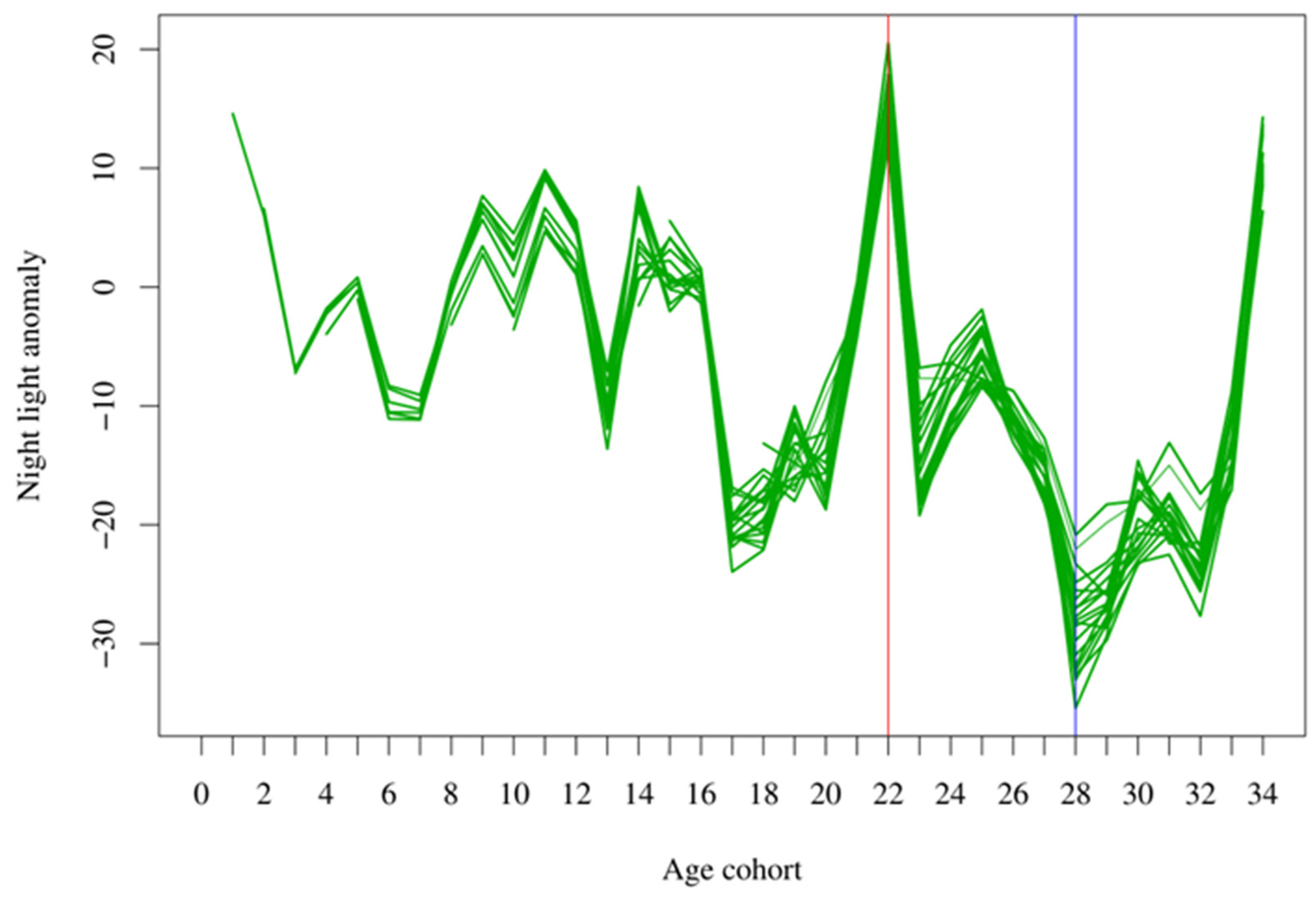
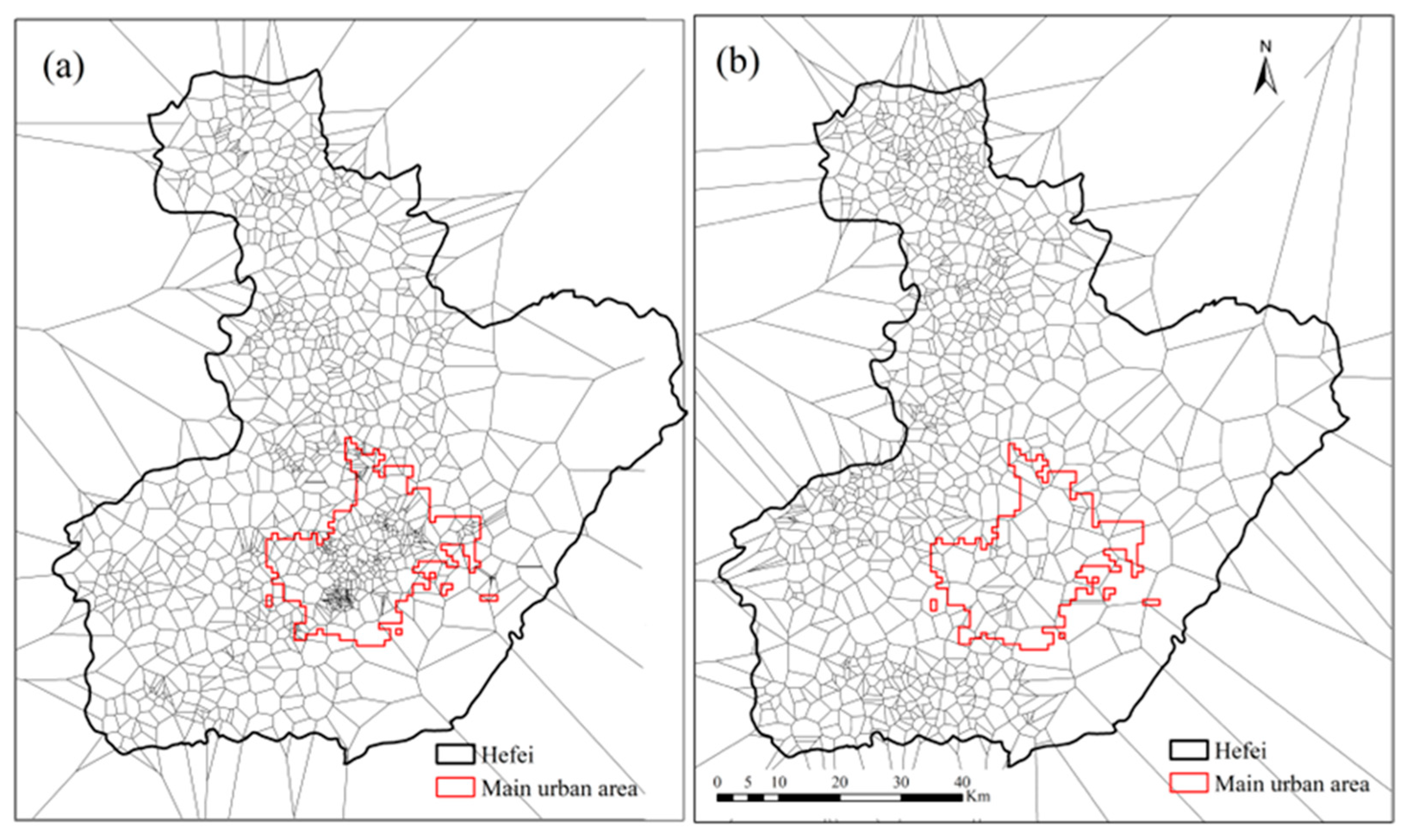
References
- Oke, T.R. City size and the urban heat island. Atmos. Environ. 1973, 7, 769–779. [Google Scholar] [CrossRef]
- Arnfield, A.J. Two decades of urban climate research: A review of turbulence, exchanges of energy and water, and the urban heat island. Int. J. Climatol. J. R. Meteorol. Soc. 2003, 23, 1–26. [Google Scholar] [CrossRef]
- Arsiso, B.K.; Tsidu, G.M.; Stoffberg, G.H.; Tadesse, T. Influence of urbanization-driven land use/cover change on climate: The case of Addis Ababa, Ethiopia. Phys. Chem. Earth Parts A/B/C 2018, 105, 212–223. [Google Scholar] [CrossRef]
- Kim, H.; Gu, D.; Kim, H.Y. Effects of Urban Heat Island mitigation in various climate zones in the United States. Sustain. Cities Soc. 2018, 41, 841–852. [Google Scholar] [CrossRef]
- Zhou, D.; Zhao, S.; Liu, S.; Zhang, L. Spatiotemporal trends of terrestrial vegetation activity along the urban development intensity gradient in China’s 32 major cities. Sci. Total Environ. 2014, 488–489, 136–145. [Google Scholar] [CrossRef] [PubMed]
- Phelan, P.E.; Kaloush, K.; Miner, M.; Golden, J.; Phelan, B.; Silva, H., III; Taylor, R.A. Urban heat island: Mechanisms, implications, and possible remedies. Annu. Rev. Environ. Resour. 2015, 40, 285–307. [Google Scholar] [CrossRef]
- Magura, T.; Ferrante, M.; Lövei, G.L. Only habitat specialists become smaller with advancing urbanization. Glob. Ecol. Biogeogr. 2020, 29, 1978–1987. [Google Scholar] [CrossRef]
- Zhang, J.; Wu, L. Influence of human population movements on urban climate of Beijing during the Chinese New Year holiday. Sci. Rep. 2017, 7, 45813. [Google Scholar] [CrossRef] [PubMed]
- Parsons, K. Human Thermal Environments: The Effects of Hot, Moderate, Andcold Environments on Human Health, Comfort, and Performance, 3rd ed.; CRC Press: Boca Raton, FL, USA, 2014; pp. 1–586. [Google Scholar]
- Kotharkar, R.; Surawar, M. Land use, land cover, and population density impact on the formation of canopy urban heat islands through traverse survey in the Nagpur urban area, India. J. Urban Plan. Dev. 2016, 142, 04015003. [Google Scholar] [CrossRef]
- Wu, L.; Zhang, J. Assessing population movement impacts on urban heat island of Beijing during the Chinese New Year holiday: Effects of meteorological conditions. Theor. Appl. Climatol. 2018, 131, 1203–1210. [Google Scholar] [CrossRef]
- Manoli, G.; Fatichi, S.; Schläpfer, M.; Yu, K.; Crowther, T.W.; Meili, N.; Burlando, P.; Katul, G.G.; Bou-Zeid, E. Magnitude of urban heat islands largely explained by climate and population. Nature 2019, 573, 55–60. [Google Scholar] [CrossRef] [PubMed]
- Mathew, A.; Khandelwal, S.; Kaul, N. Spatial and temporal variations of urban heat island effect and the effect of percentage impervious surface area and elevation on land surface temperature: Study of Chandigarh city, India. Sustain. Cities Soc. 2016, 26, 264–277. [Google Scholar] [CrossRef]
- Chithra, S.; Nair, M.H.; Amarnath, A.; Anjana, N. Impacts of impervious surfaces on the environment. Int. J. Eng. Sci. Invent. 2015, 4, 27–31. [Google Scholar]
- Nguyen, T.M.; Lin, T.-H.; Chan, H.-P. The environmental effects of urban development in Hanoi, Vietnam from satellite and meteorological observations from 1999–2016. Sustainability 2019, 11, 1768. [Google Scholar] [CrossRef]
- Parsaee, M.; Joybari, M.M.; Mirzaei, P.A.; Haghighat, F. Urban heat island, urban climate maps and urban development policies and action plans. Environ. Technol. Innov. 2019, 14, 100341. [Google Scholar] [CrossRef]
- Liang, Z.; Wu, S.; Wang, Y.; Wei, F.; Huang, J.; Shen, J.; Li, S. The relationship between urban form and heat island intensity along the urban development gradients. Sci. Total Environ. 2020, 708, 135011. [Google Scholar] [CrossRef] [PubMed]
- Xu, H.-Q.; Chen, B.-Q. Remote sensing of the urban heat island and its changes in Xiamen City of SE China. J. Environ. Sci. 2004, 16, 276–281. [Google Scholar]
- Du, H.; Wang, D.; Wang, Y.; Zhao, X.; Qin, F.; Jiang, H.; Cai, Y. Influences of land cover types, meteorological conditions, anthropogenic heat and urban area on surface urban heat island in the Yangtze River Delta Urban Agglomeration. Sci. Total Environ. 2016, 571, 461–470. [Google Scholar] [CrossRef]
- Xu, N.; Deng, F.; Liu, B.; Li, C.; Fu, H.; Yang, H.; Zhang, J. Changes in the urban surface thermal environment of a Chinese coastal city revealed by downscaling MODIS LST with random forest algorithm. J. Meteorol. Res. 2021, 35, 759–774. [Google Scholar] [CrossRef]
- Sun, F.; Liu, M.; Wang, Y.; Wang, H.; Che, Y. The effects of 3D architectural patterns on the urban surface temperature at a neighborhood scale: Relative contributions and marginal effects. J. Clean. Prod. 2020, 258, 120706. [Google Scholar] [CrossRef]
- Yang, F.; Lau, S.S.; Qian, F. Summertime heat island intensities in three high-rise housing quarters in inner-city Shanghai China: Building layout, density and greenery. Build. Environ. 2010, 45, 115–134. [Google Scholar] [CrossRef]
- Luan, X.; Yu, Z.; Zhang, Y.; Wei, S.; Miao, X.; Huang, Z.Y.; Teng, S.N.; Xu, C. Remote sensing and social sensing data reveal scale-dependent and system-specific strengths of urban heat island determinants. Remote Sens. 2020, 12, 391. [Google Scholar] [CrossRef]
- Chakraborty, T.; Sarangi, C.; Lee, X. Reduction in human activity can enhance the urban heat island: Insights from the COVID-19 lockdown. Environ. Res. Lett. 2021, 16, 054060. [Google Scholar] [CrossRef]
- Bera, D.; Das Chatterjee, N.; Mumtaz, F.; Dinda, S.; Ghosh, S.; Zhao, N.; Bera, S.; Tariq, A. Integrated Influencing Mechanism of Potential Drivers on Seasonal Variability of LST in Kolkata Municipal Corporation, India. Land 2022, 11, 1461. [Google Scholar] [CrossRef]
- Ayanlade, A. Seasonality in the daytime and night-time intensity of land surface temperature in a tropical city area. Sci. Total Environ. 2016, 557, 415–424. [Google Scholar] [CrossRef] [PubMed]
- Shi, Y.; Liu, S.; Yan, W.; Zhao, S.; Ning, Y.; Peng, X.; Chen, W.; Chen, L.; Hu, X.; Fu, B. Influence of landscape features on urban land surface temperature: Scale and neighborhood effects. Sci. Total Environ. 2021, 771, 145381. [Google Scholar] [CrossRef] [PubMed]
- Heinl, M.; Hammerle, A.; Tappeiner, U.; Leitinger, G. Determinants of urban–rural land surface temperature differences—A landscape scale perspective. Landsc. Urban Plan. 2015, 134, 33–42. [Google Scholar] [CrossRef]
- Degefu, M.A.; Argaw, M.; Feyisa, G.L.; Degefa, S. Effects of urbanization on the relationship between greenspace patterns and evolution of regional heat island in cities of Ethiopia. Chin. J. Popul. Resour. Environ. 2021, 19, 330–343. [Google Scholar] [CrossRef]
- Liu, Y.; Li, H.; Gao, P.; Zhong, C. Monitoring the spatiotemporal dynamics of urban green space and its impacts on thermal environment in Shenzhen city from 1978 to 2018 with remote sensing data. Photogramm. Eng. Remote Sens. 2021, 87, 81–89. [Google Scholar] [CrossRef]
- Yue, W.; Qiu, S.; Xu, H.; Xu, L.; Zhang, L. Polycentric urban development and urban thermal environment: A case of Hangzhou, China. Landsc. Urban Plan. 2019, 189, 58–70. [Google Scholar] [CrossRef]
- Lin, J.; Wei, K.; Guan, Z. Exploring the connection between morphological characteristic of built-up areas and surface heat islands based on MSPA. Urban Clim. 2024, 53, 101764. [Google Scholar] [CrossRef]
- Zheng, Y.; Han, Q.; Keeffe, G. An Evaluation of Different Landscape Design Scenarios to Improve Outdoor Thermal Comfort in Shenzhen. Land 2024, 13, 65. [Google Scholar] [CrossRef]
- Jamei, Y.; Rajagopalan, P.; Sun, Q.C. Spatial structure of surface urban heat island and its relationship with vegetation and built-up areas in Melbourne, Australia. Sci. Total Environ. 2019, 659, 1335–1351. [Google Scholar] [CrossRef] [PubMed]
- Qian, Y.; Li, Z.; Zhou, W.; Chen, Y. Quantifying spatial pattern of urban greenspace from a gradient perspective of built-up age. Phys. Chem. Earth Parts A/B/C 2019, 111, 78–85. [Google Scholar] [CrossRef]
- Zhong, Y.; Lin, A.; Zhou, Z.; Chen, F. Spatial pattern evolution and optimization of urban system in the Yangtze River economic belt, China, based on DMSP-OLS night light data. Sustainability 2018, 10, 3782. [Google Scholar] [CrossRef]
- Stewart, I.; Krayenhoff, E.; Voogt, J.; Lachapelle, J.; Allen, M.; Broadbent, A. Time evolution of the surface urban heat island. Earth’s Future 2021, 9, e2021EF002178. [Google Scholar] [CrossRef]
- de Lima, G.N.; Rueda, V.O.M. The urban growth of the metropolitan area of Sao Paulo and its impact on the climate. Weather. Clim. Extrem. 2018, 21, 17–26. [Google Scholar] [CrossRef]
- Zhang, W.; Jiang, J.; Zhu, Y. Spatial-temporal evolution of urban thermal environment based on spatial statistical features. Ying Yong Sheng Tai Xue Bao J. Appl. Ecol. 2015, 26, 1840–1846. [Google Scholar]
- Cai, Y.; Chen, Y.; Tong, C. Spatiotemporal evolution of urban green space and its impact on the urban thermal environment based on remote sensing data: A case study of Fuzhou City, China. Urban For. Urban Green. 2019, 41, 333–343. [Google Scholar] [CrossRef]
- Cao, J.; Zhou, W.; Wang, J.; Hu, X.; Yu, W.; Zheng, Z.; Wang, W. Significant increase in extreme heat events along an urban–rural gradient. Landsc. Urban Plan. 2021, 215, 104210. [Google Scholar] [CrossRef]
- Li, F.; Yan, Q.; Bian, Z.; Liu, B.; Wu, Z. A POI and LST adjusted NTL urban index for urban built-up area extraction. Sensors 2020, 20, 2918. [Google Scholar] [CrossRef] [PubMed]
- Zhang, X.; Li, P. A temperature and vegetation adjusted NTL urban index for urban area mapping and analysis. ISPRS J. Photogramm. Remote Sens. 2018, 135, 93–111. [Google Scholar] [CrossRef]
- Yu, Z.; Jing, Y.; Yang, G.; Sun, R. A new urban functional zone-based climate zoning system for urban temperature study. Remote Sens. 2021, 13, 251. [Google Scholar] [CrossRef]
- Zhao, X.; Huang, J.; Ye, H.; Wang, K.; Qiu, Q. Spatiotemporal changes of the urban heat island of a coastal city in the context of urbanisation. Int. J. Sustain. Dev. World Ecol. 2010, 17, 311–316. [Google Scholar] [CrossRef]
- Li, Y.; Sun, Y.; Li, J.; Gao, C. Socioeconomic drivers of urban heat island effect: Empirical evidence from major Chinese cities. Sustain. Cities Soc. 2020, 63, 102425. [Google Scholar] [CrossRef]
- Grigoraș, G.; Urițescu, B. Spatial hotspot analysis of Bucharest’s urban heat island (UHI) using modis data. Ann. Valahia Univ. Targoviste. Geogr. Ser. 2018, 18, 14–22. [Google Scholar] [CrossRef]
- Wang, J.; Huang, B.; Fu, D.; Atkinson, P.M.; Zhang, X. Response of urban heat island to future urban expansion over the Beijing–Tianjin–Hebei metropolitan area. Appl. Geogr. 2016, 70, 26–36. [Google Scholar] [CrossRef]
- Aminiyan, M.M.; Aminiyan, F.M.; Mousavi, R.; Heydariyan, A. Heavy metal pollution affected by human activities and different land-use in urban topsoil: A case study in Rafsanjan city, Kerman province, Iran. Eurasian J. Soil Sci. 2016, 5, 97–104. [Google Scholar] [CrossRef]
- Li, X.; Zhou, Y.; Yu, S.; Jia, G.; Li, H.; Li, W. Urban heat island impacts on building energy consumption: A review of approaches and findings. Energy 2019, 174, 407–419. [Google Scholar] [CrossRef]
- Grover, A.; Singh, R.B. Analysis of urban heat island (UHI) in relation to normalized difference vegetation index (NDVI): A comparative study of Delhi and Mumbai. Environments 2015, 2, 125–138. [Google Scholar] [CrossRef]
- Du, H.; Cai, Y.; Zhou, F.; Jiang, H.; Jiang, W.; Xu, Y. Urban blue-green space planning based on thermal environment simulation: A case study of Shanghai, China. Ecol. Indic. 2019, 106, 105501. [Google Scholar] [CrossRef]
- Zhang, K.; Wang, R.; Shen, C.; Da, L. Temporal and spatial characteristics of the urban heat island during rapid urbanization in Shanghai, China. Environ. Monit. Assess. 2010, 169, 101–112. [Google Scholar] [CrossRef] [PubMed]
- Qin, Z.; Dall’Olmo, G.; Karnieli, A.; Berliner, P. Derivation of split window algorithm and its sensitivity analysis for retrieving land surface temperature from NOAA-advanced very high resolution radiometer data. J. Geophys. Res. Atmos. 2001, 106, 22655–22670. [Google Scholar] [CrossRef]
- Morini, E.; Touchaei, A.G.; Castellani, B.; Rossi, F.; Cotana, F. The impact of albedo increase to mitigate the urban heat island in Terni (Italy) using the WRF model. Sustainability 2016, 8, 999. [Google Scholar] [CrossRef]
- Zhou, D.; Zhang, L.; Hao, L.; Sun, G.; Liu, Y.; Zhu, C. Spatiotemporal trends of urban heat island effect along the urban development intensity gradient in China. Sci. Total Environ. 2016, 544, 617–626. [Google Scholar] [CrossRef] [PubMed]
- Peng, S.; Piao, S.; Ciais, P.; Friedlingstein, P.; Ottle, C.; Bréon, F.-M.; Nan, H.; Zhou, L.; Myneni, R.B. Surface urban heat island across 419 global big cities. Environ. Sci. Technol. 2012, 46, 696–703. [Google Scholar] [CrossRef] [PubMed]
- Clinton, N.; Gong, P. MODIS detected surface urban heat islands and sinks: Global locations and controls. Remote Sens. Environ. 2013, 134, 294–304. [Google Scholar] [CrossRef]
- Yuan, F.; Sawaya, K.E.; Loeffelholz, B.C.; Bauer, M.E. Land cover classification and change analysis of the Twin Cities (Minnesota) Metropolitan Area by multitemporal Landsat remote sensing. Remote Sens. Environ. 2005, 98, 317–328. [Google Scholar] [CrossRef]
- Cai, D.; Fraedrich, K.; Guan, Y.; Guo, S.; Zhang, C. Urbanization and the thermal environment of Chinese and US-American cities. Sci. Total Environ. 2017, 589, 200–211. [Google Scholar] [CrossRef]
- Coseo, P.; Larsen, L. How factors of land use/land cover, building configuration, and adjacent heat sources and sinks explain Urban Heat Islands in Chicago. Landsc. Urban Plan. 2014, 125, 117–129. [Google Scholar] [CrossRef]
- Liu, Y.; Li, L.; Chen, L.; Cheng, L.; Zhou, X.; Cui, Y.; Li, H.; Liu, W. Urban growth simulation in different scenarios using the SLEUTH model: A case study of Hefei, East China. PLoS ONE 2019, 14, e0224998. [Google Scholar] [CrossRef] [PubMed]
- Jiao, H.; Zhang, X.; Yang, C.; Cao, X. The characteristics of spatial expansion and driving forces of land urbanization in counties in central China: A case study of Feixi county in Hefei city. PLoS ONE 2021, 16, e0252331. [Google Scholar] [CrossRef]
- Gong, P.; Li, X.; Wang, J.; Bai, Y.; Chen, B.; Hu, T.; Liu, X.; Xu, B.; Yang, J.; Zhang, W.; et al. Annual maps of global artificial impervious area (GAIA) between 1985 and 2018. Remote Sens. Environ. 2020, 236, 111510. [Google Scholar] [CrossRef]
- Holben, B.N. Characteristics of maximum-value composite images from temporal AVHRR data. Int. J. Remote Sens. 1986, 7, 1417–1434. [Google Scholar] [CrossRef]
- Karabulut, M. An examination of relationships between vegetation and rainfall using maximum value composite AVHRR-NDVI data. Turk. J. Bot. 2003, 27, 93–101. [Google Scholar]
- Mildrexler, D.J.; Zhao, M.; Heinsch, F.A.; Running, S.W. A new satellite-based methodology for continental-scale disturbance detection. Ecol. Appl. 2007, 17, 235–250. [Google Scholar] [CrossRef]
- Sun, W.; Wang, P.X.; Zhang, S.Y.; Zhu, D.H.; Liu, J.M.; Chen, J.H.; Yang, H.S. Using the vegetation temperature condition index for time series drought occurrence monitoring in the Guanzhong Plain, PR China. Int. J. Remote Sens. 2008, 29, 5133–5144. [Google Scholar] [CrossRef]
- Zhao, S.; Zhou, D.; Zhu, C.; Qu, W.; Zhao, J.; Sun, Y.; Huang, D.; Wu, W.; Liu, S. Rates and patterns of urban expansion in China’s 32 major cities over the past three decades. Landsc. Ecol. 2015, 30, 1541–1559. [Google Scholar] [CrossRef]
- Gong, P.; Li, X.; Zhang, W. 40-Year (1978–2017) human settlement changes in China reflected by impervious surfaces from satellite remote sensing. Sci. Bull. 2019, 64, 756–763. [Google Scholar] [CrossRef]
- Men, B.; Wu, Z.; Liu, H.; Tian, W.; Zhao, Y. Spatio-temporal Analysis of Precipitation and Temperature: A Case Study Over the Beijing–Tianjin–Hebei Region, China. Pure Appl. Geophys. 2020, 177, 3527–3541. [Google Scholar] [CrossRef]
- Lewis, F.; Butler, A.; Gilbert, L. A unified approach to model selection using the likelihood ratio test. Methods Ecol. Evol. 2011, 2, 155–162. [Google Scholar] [CrossRef]
- Chernick, M.R.; González-Manteiga, W.; Crujeiras, R.M.; Barrios, E.B. Bootstrap Methods; Springer: Berlin/Heidelberg, Germany, 2011. [Google Scholar]
- Brown, C.E. Coefficient of variation. In Applied Multivariate Statistics in Geohydrology and Related Sciences; Springer: Berlin/Heidelberg, Germany, 1998; pp. 155–157. [Google Scholar]
- Hu, D.; Meng, Q.; Zhang, L.; Zhang, Y. Spatial quantitative analysis of the potential driving factors of land surface temperature in different “Centers” of polycentric cities: A case study in Tianjin, China. Sci. Total Environ. 2020, 706, 135244. [Google Scholar] [CrossRef]
- Meng, Q.; Zhang, L.; Sun, Z.; Meng, F.; Wang, L.; Sun, Y. Characterizing spatial and temporal trends of surface urban heat island effect in an urban main built-up area: A 12-year case study in Beijing, China. Remote Sens. Environ. 2018, 204, 826–837. [Google Scholar] [CrossRef]
- van Hove, L.W.A.; Jacobs, C.M.J.; Heusinkveld, B.G.; Elbers, J.A.; van Driel, B.L.; Holtslag, A.A.M. Temporal and spatial variability of urban heat island and thermal comfort within the Rotterdam agglomeration. Build. Environ. 2015, 83, 91–103. [Google Scholar] [CrossRef]
- Mumtaz, F.; Li, J.; Liu, Q.; Arshad, A.; Dong, Y.; Liu, C.; Zhao, J.; Bashir, B.; Gu, C.; Wang, X. Spatio-temporal dynamics of land use transitions associated with human activities over Eurasian Steppe: Evidence from improved residual analysis. Sci. Total Environ. 2023, 905, 166940. [Google Scholar] [CrossRef]
- Wang, X.; Zhou, T.; Tao, F.; Zang, F. Correlation analysis between UBD and LST in Hefei, China, using Luojia1-01 night-time light imagery. Appl. Sci. 2019, 9, 5224. [Google Scholar] [CrossRef]
- Nganyiyimana, J.; Ngarambe, J.; Yun, G.Y. Nighttime light: A potential proxy for local nocturnal urban heat island intensity in seoul. J. Green Build. 2023, 18, 29–41. [Google Scholar] [CrossRef]
- Cai, Z.; Tang, Y.; Zhan, Q. A cooled city? Comparing human activity changes on the impact of urban thermal environment before and after city-wide lockdown. Build. Environ. 2021, 195, 107729. [Google Scholar] [CrossRef]
- Kammuang-Lue, N.; Sakulchangsatjatai, P.; Sangnum, P.; Terdtoon, P. Influences of population, building, and traffic densities on urban heat island intensity in Chiang Mai City, Thailand. Therm. Sci. 2015, 19, 445–455. [Google Scholar] [CrossRef]
- Al-Mohannadi, M.S. Motorized Transportation and the UHI Effect in Doha: The Impact of Traffic on the Heat Island Effect. Ph.D. Dissertation, Qatar University, Doha, Qatar, 2017. [Google Scholar]
- Zhao, Z.; Sharifi, A.; Dong, X.; Shen, L.; He, B.-J. Spatial variability and temporal heterogeneity of surface urban heat island patterns and the suitability of local climate zones for land surface temperature characterization. Remote Sens. 2021, 13, 4338. [Google Scholar] [CrossRef]
- Yang, X.; Li, Y. The impact of building density and building height heterogeneity on average urban albedo and street surface temperature. Build. Environ. 2015, 90, 146–156. [Google Scholar] [CrossRef]
- Odunuga, S.; Badru, G. Landcover change, land surface temperature, surface albedo and topography in the Plateau Region of North-Central Nigeria. Land 2015, 4, 300–324. [Google Scholar] [CrossRef]
- Bonafoni, S.; Baldinelli, G.; Rotili, A.; Verducci, P. Albedo and surface temperature relation in urban areas: Analysis with different sensors. In Proceedings of the 2017 Joint Urban Remote Sensing Event (JURSE), Dubai, United Arab Emirates, 6–8 March 2017; pp. 1–4. [Google Scholar]
- Li, T.; Yu, B.; Hu, Z.; Chen, Z. Numerical simulation on impact of building density on urban heat island with an urban porous media model. Hsi-Chiao Tung Ta Hsueh/J. Xi’an Jiaotong Univ. 2012, 46, 134–138. [Google Scholar]
- Zheng, Z.; Zhou, W.; Yan, J.; Qian, Y.; Wang, J.; Li, W. The higher, the cooler? Effects of building height on land surface temperatures in residential areas of Beijing. Phys. Chem. Earth Parts A/B/C 2019, 110, 149–156. [Google Scholar] [CrossRef]
- Yu, W.; Yang, J.; Cong, N.; Ren, J.; Yu, H.; Xiao, X.; Xia, J. Attribution of urban diurnal thermal environmental change: Importance of global–local effects. IEEE J. Sel. Top. Appl. Earth Obs. Remote Sens. 2023, 16, 8087–8101. [Google Scholar] [CrossRef]
- Buyantuyev, A.; Wu, J. Urban heat islands and landscape heterogeneity: Linking spatiotemporal variations in surface temperatures to land-cover and socioeconomic patterns. Landsc. Ecol. 2010, 25, 17–33. [Google Scholar] [CrossRef]
- Estoque, R.C.; Murayama, Y.; Myint, S.W. Effects of landscape composition and pattern on land surface temperature: An urban heat island study in the megacities of Southeast Asia. Sci. Total Environ. 2017, 577, 349–359. [Google Scholar] [CrossRef] [PubMed]
- Thomaz, S.M.; Agostinho, A.A.; Gomes, L.C.; Silveira, M.J.; Rejmanek, M.; Aslan, C.E.; Chow, E. Using space-for-time substitution and time sequence approaches in invasion ecology. Freshw. Biol. 2012, 57, 2401–2410. [Google Scholar] [CrossRef]
- Damgaard, C. A critique of the space-for-time substitution practice in community ecology. Trends Ecol. Evol. 2019, 34, 416–421. [Google Scholar] [CrossRef]
- Blois, J.L.; Williams, J.W.; Fitzpatrick, M.C.; Jackson, S.T.; Ferrier, S. Space can substitute for time in predicting climate-change effects on biodiversity. Proc. Natl. Acad. Sci. USA 2013, 110, 9374–9379. [Google Scholar] [CrossRef]
- Wogan, G.O.; Wang, I.J. The value of space-for-time substitution for studying fine-scale microevolutionary processes. Ecography 2018, 41, 1456–1468. [Google Scholar] [CrossRef]
- Julien, Y.; Sobrino, J.A.; Mattar, C.; Ruescas, A.B.; Jimenez-Munoz, J.C.; Soria, G.; Hidalgo, V.; Atitar, M.; Franch, B.; Cuenca, J. Temporal analysis of normalized difference vegetation index (NDVI) and land surface temperature (LST) parameters to detect changes in the Iberian land cover between 1981 and 2001. Int. J. Remote Sens. 2011, 32, 2057–2068. [Google Scholar] [CrossRef]
- Marzban, F.; Sodoudi, S.; Preusker, R. The influence of land-cover type on the relationship between NDVI–LST and LST-T air. Int. J. Remote Sens. 2018, 39, 1377–1398. [Google Scholar] [CrossRef]
- Fatemi, M.; Narangifard, M. Monitoring LULC changes and its impact on the LST and NDVI in District 1 of Shiraz City. Arab. J. Geosci. 2019, 12, 127. [Google Scholar] [CrossRef]
- Fabeku, B.B.; Balogun, I.A.; Adegboyega, S.A.-A.; Faleyimu, O.I. Spatio-temporal variability in land surface temperature and its relationship with vegetation types over Ibadan, south-western Nigeria. Atmos. Clim. Sci. 2018, 8, 318–336. [Google Scholar] [CrossRef]
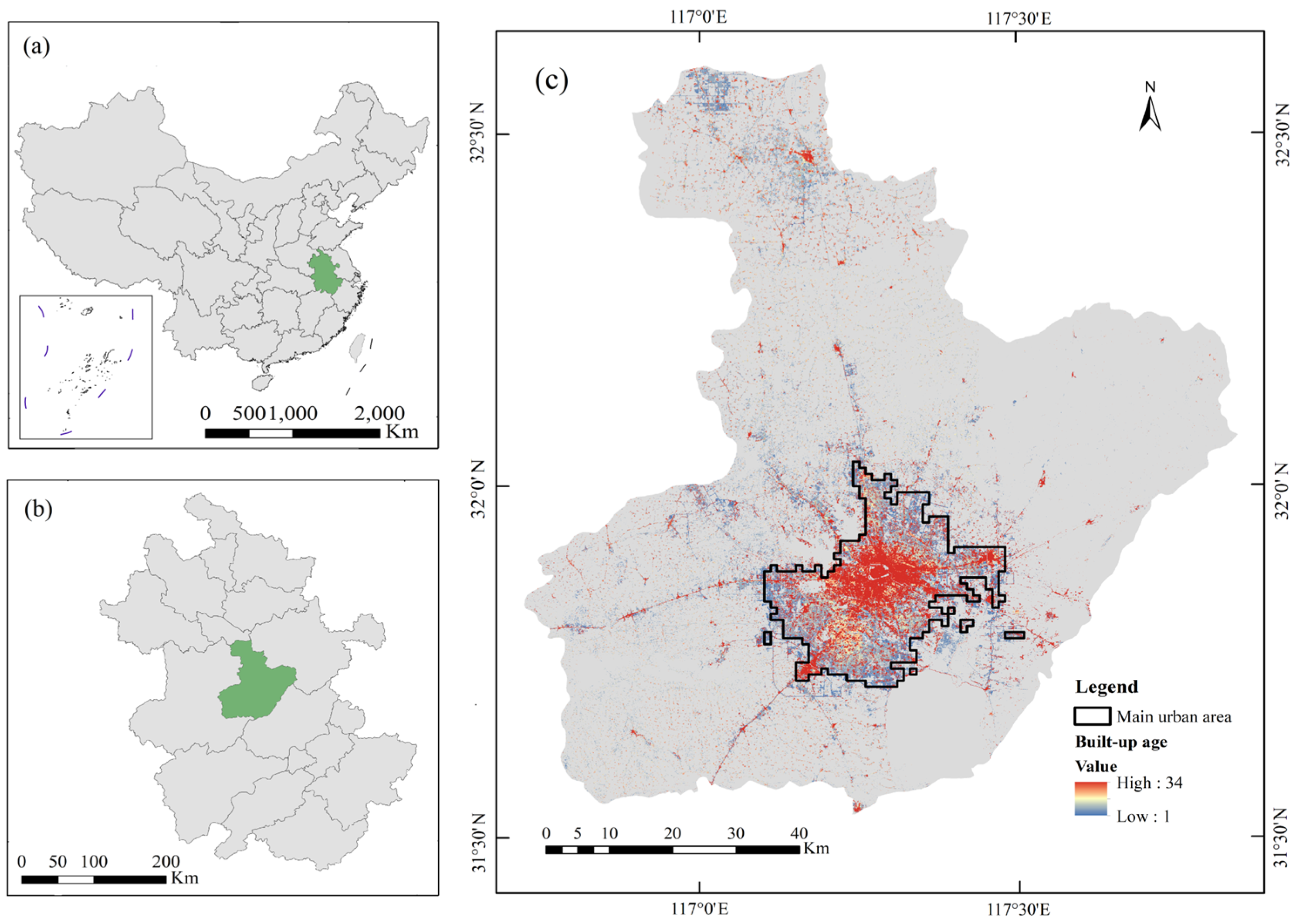

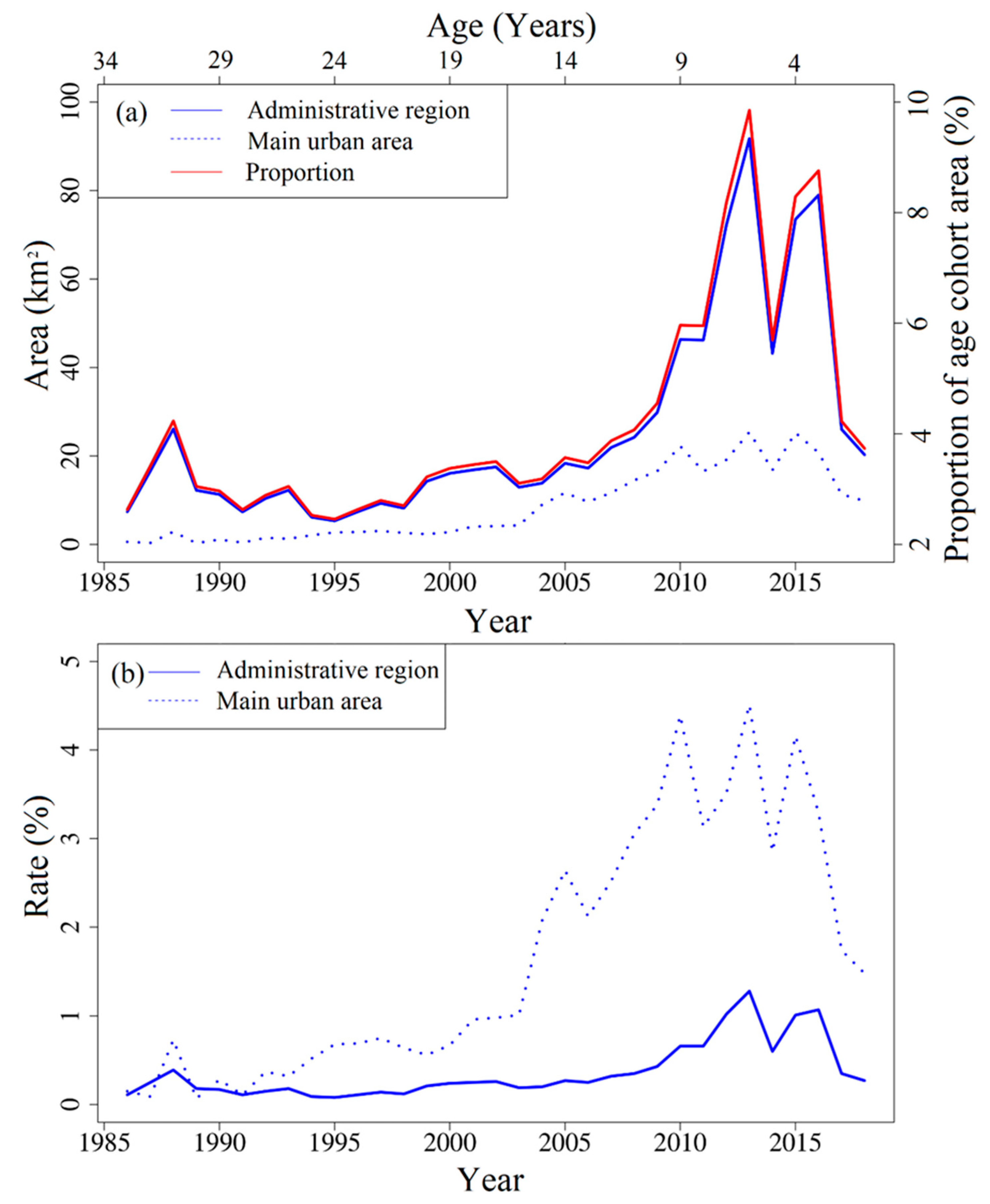

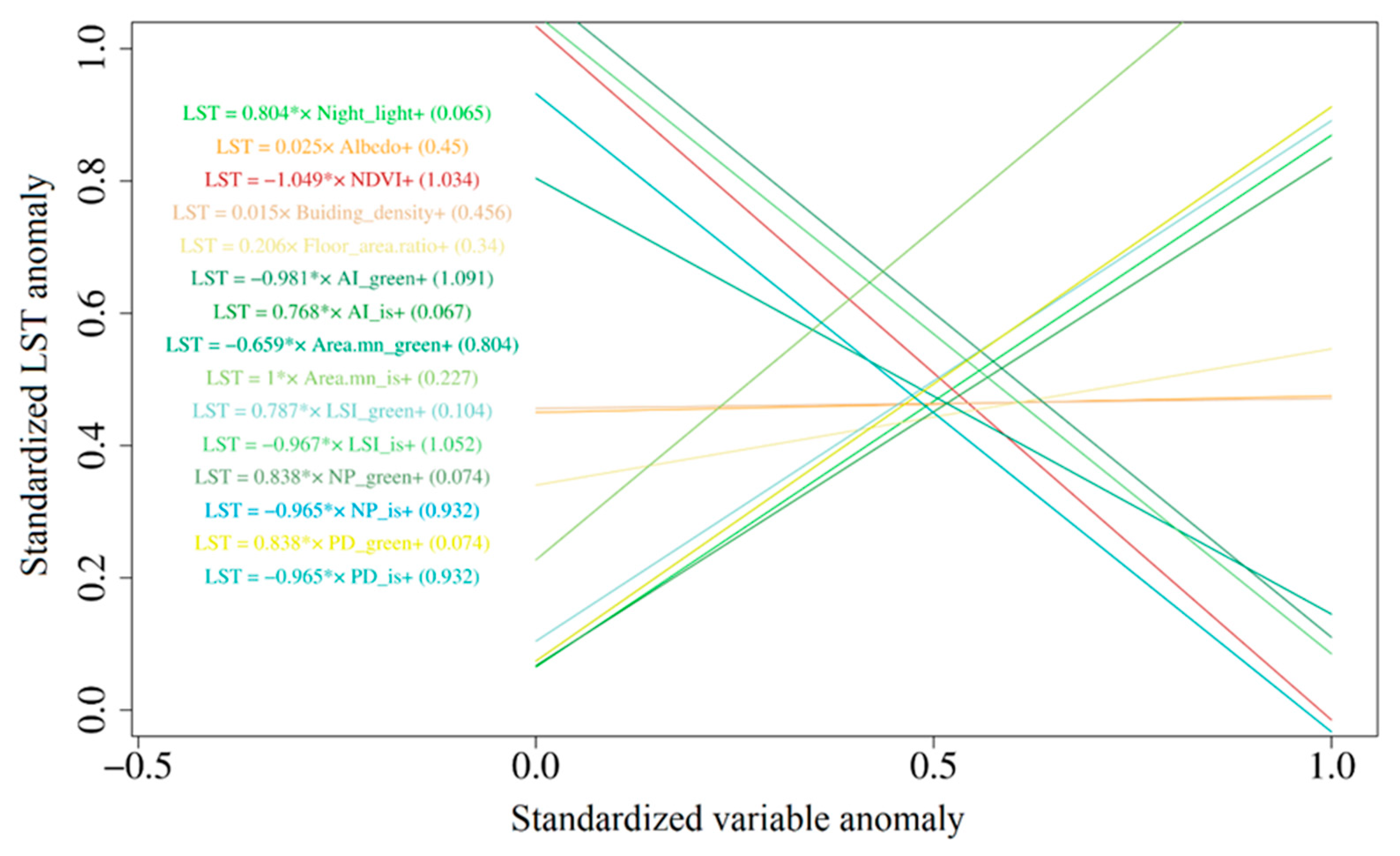
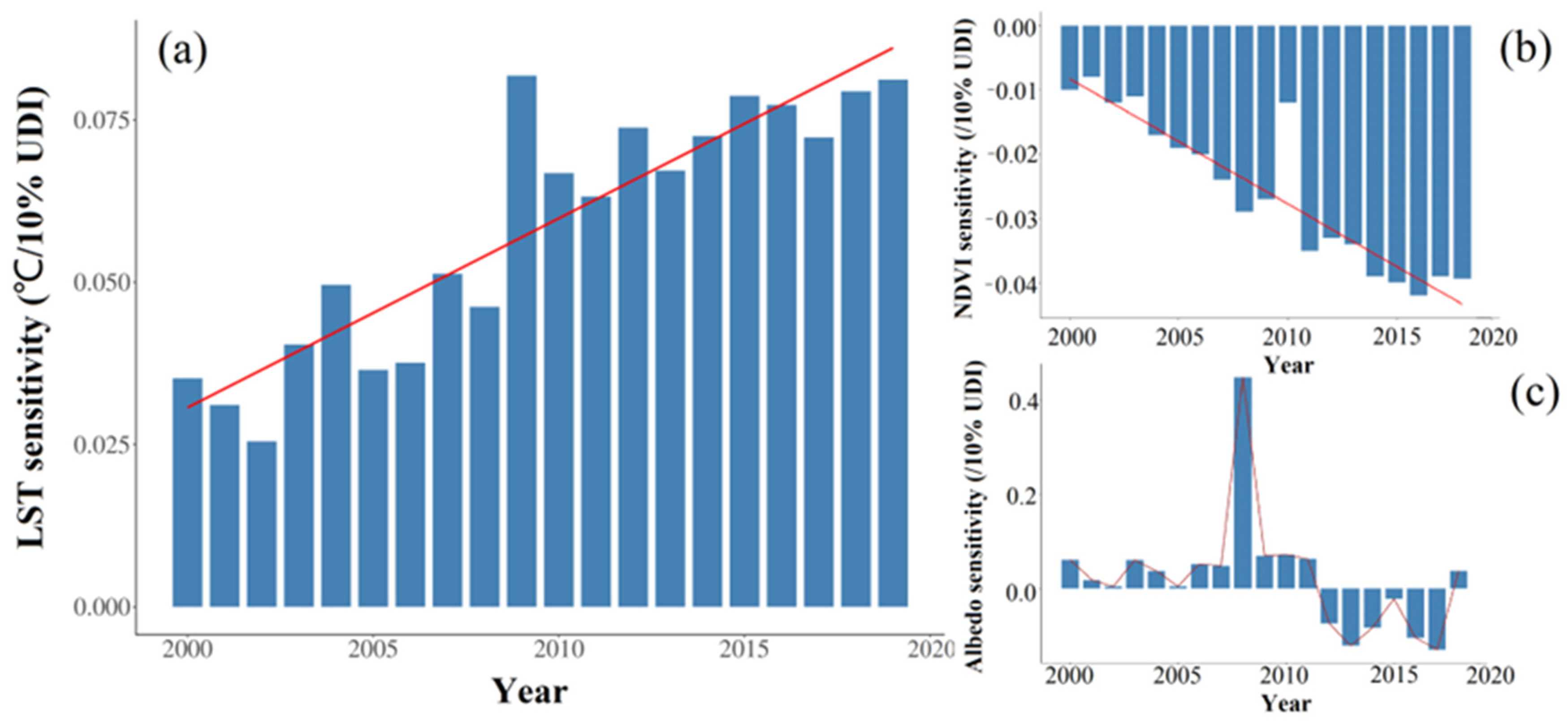
| Dataset | Spatial Resolution | Year | Pre-Processing | Purpose |
|---|---|---|---|---|
| Aqua MODIS 8-day composite products LST | 1 km | 2000–2019 | MVC, Mosaic | To calculate the annual maximum LST from 2000 to 2019 |
| Global artificial Impervious surface | 30 m | 1985–2018 | Reclassify, Resample, Mosaic | To calculate the built-up age and UDI |
| Land Use/cover | 30 m | 2017 | Resample, Mosaic | To extract the main urban area and calculate the landscape metrics |
| DMSP/OLS Night light | 1 km | 2000–2013 | Resample, Mosaic | To conduct attribution analysis |
| VIIRS Night light | 500 m | 2013–2018 | Resample, Mosaic | To conduct attribution analysis |
| Landsat Thematic Mapper (TM) and Enhanced Thematic Mapper Plus (ETM+) images | 30 m | 2018 | Interpolation, Atmospheric Correction, De-cloud, Band Data Scaling | To calculate NDVI |
| MODIS MCD43A4 | 500 m | 2018 | Resample, Mosaic | To conduct attribution analysis |
Disclaimer/Publisher’s Note: The statements, opinions and data contained in all publications are solely those of the individual author(s) and contributor(s) and not of MDPI and/or the editor(s). MDPI and/or the editor(s) disclaim responsibility for any injury to people or property resulting from any ideas, methods, instructions or products referred to in the content. |
© 2024 by the authors. Licensee MDPI, Basel, Switzerland. This article is an open access article distributed under the terms and conditions of the Creative Commons Attribution (CC BY) license (https://creativecommons.org/licenses/by/4.0/).
Share and Cite
Li, Y.; Liu, S.; Liu, M.; Guo, R.; Shi, Y.; Peng, X.; Feng, S. Evolution and Built-Up Age Dependency of Urban Thermal Environment. Remote Sens. 2024, 16, 1495. https://doi.org/10.3390/rs16091495
Li Y, Liu S, Liu M, Guo R, Shi Y, Peng X, Feng S. Evolution and Built-Up Age Dependency of Urban Thermal Environment. Remote Sensing. 2024; 16(9):1495. https://doi.org/10.3390/rs16091495
Chicago/Turabian StyleLi, Yuanyuan, Shuguang Liu, Maochou Liu, Rui Guo, Yi Shi, Xi Peng, and Shuailong Feng. 2024. "Evolution and Built-Up Age Dependency of Urban Thermal Environment" Remote Sensing 16, no. 9: 1495. https://doi.org/10.3390/rs16091495
APA StyleLi, Y., Liu, S., Liu, M., Guo, R., Shi, Y., Peng, X., & Feng, S. (2024). Evolution and Built-Up Age Dependency of Urban Thermal Environment. Remote Sensing, 16(9), 1495. https://doi.org/10.3390/rs16091495





